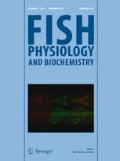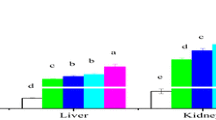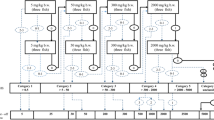Abstract
Atlantic salmon (Salmo salar L.) parr were fed for one month on fish meal based diets supplemented with Cd (0, 0.7, or 204 mg Cd kg−1 DW) or Cu (0, 34, or 691 mg Cu kg−1 DW) to assess the effects of non-essential (Cd) and essential (Cu) dietary metals on lipid peroxidation and the oxidative defence system. Cadmium accumulated significantly in the liver, intestine, and kidney of 204 mg Cd kg−1exposed fish compared to controls. Copper accumulated significantly in the intestine, kidney, and liver of fish exposed to 691 mg Cu kg−1, and in the intestine of 34 mg Cu kg−1 exposed fish. Tissue Cu accumulation significantly increased intestinal and hepatic lipid peroxidation (as seen from thiobarbituric acid reactive substances, TBARS, levels) and subsequently decreased intestinal α-tocopherol levels and increased intestinal and hepatic selenium dependent glutathione peroxidase (SeGSH-Px) activity. Dietary Cd significantly reduced SeGSH-Px activity in the intestine and liver of 204 mg Cd kg−1 exposed fish compared to controls. No significant increase in tissue TBARS or reduction of α-tocopherol levels was observed in the intestine of fish exposed to dietary Cd, with exception of the highest exposure group (204 mg Cd kg−1). Dietary Cu caused depletion of tissue Se and glutathione levels, however the reduced availability of GSH and Se did not seem to explain the differences in SeGSH-Px activity. Dietary Cu had a direct effect on lipid peroxidation at a relatively low concentration (34 mg Cu kg−1). Cadmium indirectly affected tissue lipid peroxidation by damaging the oxidative defence system at the highest dietary concentration (204 mg Cd kg−1).
Similar content being viewed by others
References
Anderson, M.E. 1989. Enzymatic and chemical methods for the determination of glutathione. In : Glutathione: Chemical, Biochemical and Medical Aspects. Vol. A, pp. 339–365. Edited by D. Dolphin, R. Poulsen and O. Avramovic. John Wiley and Sons, London.
Austreng, E., Storebakken, T. and Åsgård, T. 1987. Growth rate estimates for cultured Atlantic salmon and rainbow trout. Aquaculture 60: 157–160.
Baker, R.T.M. and Davies, S.J. 1996. Oxidative nutritional stress associated with feeding rancid oils to African catfish, Clarias gariepinus (Burchell) and the protective role of α -tocopherol. Aquacult. Res. 27: 795–803.
Baker, R.T.M., Handy, R.D., Davies, S.J. and Snook, J.C. 1998. Chronic dietary exposure to copper affects growth, tissue lipid peroxidation, and metal composition of the grey mullet, Chelon labrosus . Mar. Environ. Res. 45: 357–365.
Bell, J.G., Cowey, C.B., Adron, J.W. and Shanks, A.M. 1985. Some effects of vitamin E and selenium deprivation on tissue enzyme levels and indices of tissue peroxidation in rainbow trout (Salmo gairdneri ). Brit. J. Nutr. 53: 149–157.
Bem, E.M., Mailer, K. and Elson, C.M. 1985. Influence of mercury(II), cadmium(II), methylmercury(II), and phenylmercury on the kinetics properties of rat liver glutathione peroxidase. Can. J. Biochem. Cell Biol. 63: 1212–1216.
Berntssen, M.H.G., Hylland, K., Wendelaar Bonga, S.E. and Maage, A. 1999a. Toxic levels of dietary Cu in Atlantic salmon (Salmo salar L.) pre-smolt. Aquat. Toxicol. 46: 87–99.
Berntssen M.H.G., Lundebye, A.-K. and Maage, A. 1999b. Effects of elevated dietary copper concentrations on growth, feed utilisation and nutritional status of Atlantic salmon (Salmo salar L.) fry. Aquaculture 174:167–181.
Brodtkorb, B.T., Lie, Ø. and Hamre, K. 1999. Dietary levels of lipid, pro-and antioxidants-effects on lipid turnover and composition in Atlantic salmon (Salmo salar L.)with emphasis in lipoproteins and eye. Lipids (submitted).
Canesi, L., Viarengo, A., Leonzio, C., Filippelli, M. and Gallo, G. 1999. Heavy metals and glutathione metabolism in mussel tissues. Aquat. Toxicol. 46: 67–76.
Esworthy, R.S., Chu, F.F., Geiger, P., Girotti, A.W. and Doroshow, J.H. 1993. Reactivity of plasma glutathione peroxidase with hydroperoxide substrates and glutathione. Arch. Biochem. Biophys. 307: 29–34.
Fairweather-Tait, S.J. 1997. Bioavailability of copper. European J. Clinical Nutrition, Suppl. 1: 24–26.
Farag, A.M., Boese, C.J., Woodward, D.F. and Bergman, H.L. 1994. Physiological changes and tissue metal accumulation in rainbow trout exposed to foodborne and waterborne metals. Environ. Toxicol. Chem. 13: 2021–2029.
Freedman, J.H., Ciriolo, M.R. and Peisach, J. 1989. The role of glutathione in copper metabolism and toxicity. J. Biol. Chem. 264: 5598–5605.
Girotti, A.W. 1998. Lipid hydroperoxide generation, turnover, and acceptor action in biological systems. J. Lipid Res. 39: 1529–1542.
Halliwell, B. and Gutteridge, J.M.C. 1993. In : Free radicals in biology and Medicine. pp. 12–20. Clarendon Press. Oxford.
Hamre, K., Waagbo, R., Berge, R.K. and Lie, O. 1997. Vitamins C and E interact in juvenile Atlantic salmon (Salmo salar , L). Free Rad. Biol. 22: 137–149.
Handy, R.D. 1992. The assessment of episodic metal pollution. II. The effects of cadmium and copper enriched diets on tissue contamination analysis in rainbow trout (Oncorhynchus mykiss ). Arch. Environ. Contam. Toxicol. 22: 82–87.
Handy, R.D. 1993. The effect of acute exposure to dietary Cd and Cu on organ toxicant concentrations in rainbow trout, Onchorhynchus mykiss , Aquatic Toxicol. 27: 1–14.
Handy, R.D. 1996. Dietary exposure to toxic metals in fish. In : Toxicology of Aquatic Pollution Physiological, Cellular and Molecular Approaches. pp. 36–41. Edited by E.W. Taylor. Cambridge University Press, Cambridge.
Hilton, J.W. 1989. The interaction of vitamins, minerals and diet composition in the diet of fish. Aquaculture 79: 223–244.
Kanazawa, K. and Ashida, H. 1998. Catabolic fate of dietary trilinoleoylglycerol hydroperoxides in rat gastrointestine. Biochimica et Biophysica Acta 1393: 336–348.
Lanno, R.P., Slinger, S.J. and Hilton, J.W. 1985. Maximum tolerable and toxicity levels of dietary copper in rainbow trout (Salmo gairdneri Richardson). Aquaculture 49: 257–268.
Lie, Ø., Sandvin, A. and Waagbø, R. 1994. Transport of tocopherol in Atlantic salmon (Salmo salar ) during vitellogenesis. Fish Physiol. Biochem. 13: 241–247.
Lorentzen, M., Maage, A. and Julshamn, K. 1998. Supplementing copper to a fishmeal baseddiet fed to Atlantic salmon parr affects liver copper and selenium concentrations. Aquacult. Nutr. 4: 67–72.
Lowry, O.H., Rosebrough, N.J., Farr, A.L. and Randall, R.J. 1951. Protein measurement with folin phenol reagent. J. Biol. Chem. 193: 265–275.
Lundebye, A.K., Berntssen, M.H.G., Wendelaar Bonga, S.E. and Maage, A. 1999. Biochemical and physiological parameters in Atlantic salmon (Salmo salar ) following dietary exposure to copper and cadmium. Mar. Pol. Bull. (in press).
Maage, A. 1990. Comparison of cadmium concentrations in Atlantic salmon (Salmo salar ) fry fed different commercial feeds. Bull. Environ. Contam. Toxicol. 44: 770–775.
Maage, A., 1994. Trace elements in Atlantic salmon Salmo salar nutrition. Ph.D. Thesis, University of Bergen, Bergen, Norway 20 pp.
Maage, A., Julshamn, K. and Andersen, K.-J. 1991. Determination of selenium in acid digested marine samples by electrothermal atomic-absorption spectrometry with continuum source background correction and nickel as a chemical modifier. J. Analyt. Atom Spectrom. 6: 277–281.
Nagalakshmi, N. and Prasad, M.H.V. 1998. Copper-induced oxidative stress in Scenedesmus bijugatus : protective role of free radical scavengers. Bull. Environ. Contam. Toxicol. 61: 623–628.
Nebergall, W.H., Schmidt, F.C. and Holtzclaw Jr., H.F. 1968. In : College Chemistry with Qualitative Analyses. pp. 534–536. Edited by J.C. Bailar. Heath and Co., Lexington.
Ognjanovic, B., Zikic, R.V., Stajn, A., Saicic, Z.S., Kostic, M.M. and Petrovic, V.M. 1995. The effects of selenium on the antioxidant defence system in the liver of rats exposed to cadmium. Physiol. Res. 44: 293–300.
Omaye, S.T. and Tappel, A.L. 1975. Effect of cadmium chloride on the rat testicular soluble seleno-enzyme, glutathione peroxidase. Res. Commun. Chem. Pathol. Pharmacol. 12: 695–711.
Oster, O., Schmiedel, G. and Prellwitz, W. 1988. The organ distribution of selenium in German adults. Biol. Trace Elements Res. 515: 23–45.
Pokorný, J. 1987. Major factors affecting auto-oxidation. In : Autoxidation of Unsaturated Lipids. pp. 141–207. Edited by H.W. Chan. Academic Press, London.
Rabestein, D.L., Gueremont, R. and Evans, C.A. 1985. Glutathione and its metal-complexes. In : Metal Ions in Biological Systems. pp. 104–141. Edited by H. Siegel. Marcel Dekker, New York.
Rana, S.V.S. and Boora, P.R. 1992. Antiperoxidative mechanism offered by selenium against liver injury caused by cadmium and mercury in rat. Bull. Env. Cont. Toxicol. 48: 120–124.
Rana, S.V.S and Verma, S. 1996. Protective effects of GSH, vitamin E, and selenium on lipid peroxidation in cadmium fed rats. Biol. Trace Element Res. 15: 161–168.
Rana, S.V.S., and Verma, S. 1997. Protective effects of GSH, a-tocopherol, and selenium on lipid peroxidation in liver and kidney of copper fed rats. Bull. Environ. Contam. Toxicol. 59: 152–158.
Recknagel, R.O. and Glende, E.A. Jr. 1977. Lipid peroxidation: A specific form of cellular injury. In : Handbook of Physiology: Reactions to Environmental Agents. Vol. 9, pp. 591–601. Edited by D.H.K. Lee. American Physiological Society, Bethesda.
Ridlington, J.W. and Whanger, P.D. 1981. Interactions of selenium and antioxidants with mercury, cadmium and silver. Fundam. Appl. Toxicol. 1: 368–374.
Sarkar, S., Yadav, P. and Bhatnagar, D. 1997. Cadmium-induced lipid peroxidation and the antioxidant system in rat erythrocytes: The role of antioxidants. Trace Elements Med. Biol. 11: 8–13.
Schlenk, D. and Rice, C.D. 1998. Effects of zinc and cadmium treatment on hydrogen peroxide-induced mortality and expression of glutathione and metallothionien in a teleost hepatoma cell line. Aquat. Toxicol. 43: 121–129.
Schmedes, A. and Hölmer, G. 1989. A new thiobarbituric acid (TBA) method for determining free malondialdehyde (MDA) and hydroperoxides selective as a measure of lipid-peroxidation. J. Am. Oil Chemists Society. 6: 813–817.
Sokal, R.R. and Rohlf, F.J. 1981. Biometry, 2nd ed. W.H. Freeman & Co., New York.
Splittgerber, A.G. and Tappel, A.L. 1979. Inhibition of glutathione peroxidase by cadmium and other metals. Arch. Biochem. Biophys. 197: 534–542.
Thomas, P. and Wofford, W. 1984. Effects of metals and organic compounds on hepaticglutathione, cysteine and acid soluble thiol-levels in mullet (Mugil cephaius ). Toxicol. Appl. Pharmacol. 76: 172–182.
Thomas, P. and Wofford, W. 1993. Effects of cadmium and Aroclor 1254 on lipid peroxidation, glutathione peroxidase activity, and selected antioxidants in Atlantic croaker tissues. Aquat. Toxicol. 27: 159–178.
Tort, L., Krgacin, B., Torres, P., Giralt, M. and Hidalgo, J. 1996. The effect of cadmium exposure and stress on plasma cortisol, metallothionein levels and oxidative status in rainbow trout (Oncorhynchus mykiss ) liver. Comp. Biochem. Physiol. C-Pharm. Toxicol. Endocr. 144: 29–34.
Viarengo, A. and Nott, J. 1993. Mechanisms of heavy metal cation homeostasis in marine invertebrates. Comp. Biochem. Physiol. C. 104: 355–372.
Wilhelm, J. 1990. Metabolic aspects of membrane lipid peroxidation. Acta Universitas Carolinae Medica 37: 1–50.
Wingler, K., Bocher, M., Flohe, L., Kollmus, H. and Brigelius Flohe, R. 1999. mRNA stability and selenocysteine insertion sequence efficiency rank gastrointestinal glutathione peroxidase high in the hierarchy of selenoproteins. Europ. J. Biochem. 259: 149–157.
Winston, G.W. and DiGiulio, R.T. 1991. Prooxidant and antioxidant mechanisms in aquatic organisms. Aquat. Toxicol. 19: 137–161.
Zar, J.H. 1984. Biostatistical Analysis, 2nd ed. Prentice-Hall, Englewood Cliffs, N.J.
Author information
Authors and Affiliations
Rights and permissions
About this article
Cite this article
Berntssen, M.H., Lundebye, AK. & Hamre, K. Tissue lipid peroxidative responses in Atlantic salmon (Salmo salar L.) parr fed high levels of dietary copper and cadmium. Fish Physiology and Biochemistry 23, 35–48 (2000). https://doi.org/10.1023/A:1007894816114
Issue Date:
DOI: https://doi.org/10.1023/A:1007894816114




